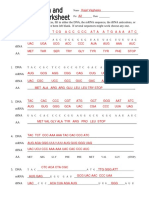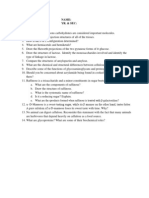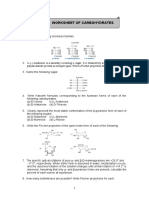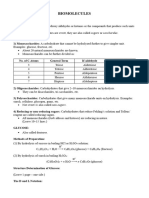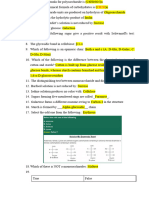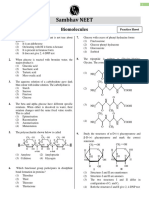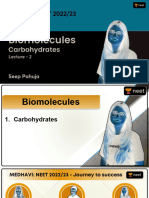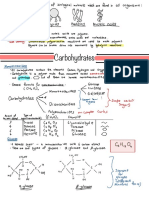Unit 2 Model Questions on Carbohydrates
Uploaded by
sankalpadas194Unit 2 Model Questions on Carbohydrates
Uploaded by
sankalpadas194Carbohydrates
1. Is sucrose a reducing sugar? Explain. Draw its Howarth projection. (1+2)
2. What is mutarotation? How did it help in postulating cyclic structure of glucose? (2)
3. About how many glucose units may be present in an amylopectin molecule having
average molecular weight of 275000. (2)
4. Differentiate between cellulose, starch and glycogen structurally. (2)
5. How are NAG and Nam related structurally? (3)
6. Convert glucose to fructose. (2)
7. State the biological functions of polysaccharides. (2)
8. Why humans can’t digest fibres? (2)
9. What happens when maltose is hydrolyzed by maltase? (2)
10. What happens when amylopectin is treated with β-amylase? (2)
11. What is inversion of sugar? How can it be measured? (1+1)
12. In case of D-glucose, β-anomer is 64% but for mannose, β-anomer is only 36%.
Explain.
13. Mutarotation of glucose is facile in presence of 2-hydroxy pyridine – Explain. (2)
14. Prove that amylopectin has branched chains
15. Comment on the optical activity of the product obtained by oxidation of D(-)ribose with nitric
acid. (2)
16. How are glucose, galactose and mannose related? (2)
17. Glycosides are stable towards base but susceptible towards acid – Explain. (2)
18. What is Smith degradation? (2)
19. What is the major polysaccharide present in the plant cell wall? Write its hydrolysis
product in presence of HCl.
20. Give the structure of Sucrose. (2)
21. Glucose and fructose form the same osazone – Justify. (2)
22. Distinguish between ribose and deoxyribose chemically. (2)
23. Write the structure of α-D-glucopyranose &explain the phenomenon of mutarotation
associated with it.
24. What are meant by 1) heteropolysaccharides 2) invertsugar?
25. Explain the term mutarotation with a sp. example. Discuss the mechanism of this
transformation reaction in detail.
26. Compare the structural segment of starch (amylose) with cellulose
27. Interpret the observation that sucrose is not a reducing sugar but maltose is.
28. What is deoxy sugar? Give examples:- How will you identify it?
29. Why beta D- glucose oxidized more rapidly than that of alpha- D glucose?
30. How does an epimer differs from an anomer? Illustrate with suitable example.
31. Give an example of an amino-sugar.
32. Why is sucrose known as invert sugar?
33. Mutarotation always occur in presence of acid and base only —comment.
34. Write down a structure of heteropolysaccharides?
35. Classify carbohydrates with an example in each category.
36. Mutarotation of D-glucose is due to spontaneous anomerisation- explain.
37. Write the structure of the following as indicated: i) α-D-Glucosamine (Haworth
projection formula). ii) D-Ribulose (Fischer projection formula)
38. Define : i) Axial bond ii) Equatorial bond
39. Distinguish :conformation and configuration.
40. Define the following 1. Monosaccharide 2. Stereoisomers 3. Epimers 4.
Mutarotation 5. Glycosidic bond
41. Short notes on : 1. Asymmetric centers 2. Enantiomers 3. Glycosides 4. Mutarotation
42. Differeniate between : 1. Monosaccharides and Oligosaccharides
2. Glucose and Fructose 3. Enantiomers and Distereomers 4. Aldose and Ketose
5. D and L isomers 6. Enantiomers and Epimers 7. Αlpha and beta anomers
43. Draw fischer projections for D-glucose, D-galactose, D-mannose, D-fructose
44. Draw Haworth β and α projections of: D-glucose, D-galactose and D-fructose.
45. What are enantiomers?
46. Give the structure of beta-D-methylfructofuranoside.
47. Pyranose and Furanose form which one is more stable and why?
48. Name with fischer projection formula of following sugars:
aldotriose, aldotetrose, aldopentose and aldohexose.
ketotetrose, ketopentose and ketohexose.
Find out how many asymmetric carbon atom contain and how many optical isomer possible for
above mentiuoned sugars.
49. Chair or boat which form is more stable and why?
50. chair form structure of alpha D- & Beta D- glucopyranose.
51. Howath projection formula for maltose, lactose and sucrose.
52. Difference between storage and structural polysaccharides.
53. starch Vs glycogen
54. characteristic features of peptidoglycan, cellulose and chitin
55. What are amylase and amylopectin. make a comparision in between them.
56. write down the structure of Muramic acid and N-acetyl neuraminic acid. where they are found
with one significance of them.
57. General formula of carbohydrates. with exception of formulas.
58. Mutorotation is a mechanism of acid –base catalysis reaction explain.
59. Mutorotation occur in presence of amphoteric solvent or in presence of pyridine and cresol
Why?
60. What do you mean by hemiacetal form of sugar?
1. .Name three disaccharides and draw their structures
2. Name four homopolysaccharides and draw their structures
3. Name two heteropolysaccharides and draw their structures
4. What kind of glycosidic bond is made between two glucose molecules? What is the name of this
disaccharide?
5. What kind of glycosidic bond is made between glucose and galactose? What is the name of this
disaccharide?
6. What kind of glycosidic bond is made between glucose and fructose? What is the name of this
disaccharide?
7. What types of bonds are in amylose? Does it have any branches? What type of bonds are in the
branches?
8. What types of bonds are in amylopectin? Does it have any branches? What type of bonds are in the
branches?
9. What types of bonds are in glycogen? Does it have any branches? What type of bonds is in the
branches?
Differentiate between
1. Disaccharides and Oligosaccharides
2. Maltose and Lactose
3. Amylopectin and Amylose
4. Starch and glycogen
5. Cellulose and Chitin
6. Proteoglycans and Glycoproteins
Fisher & Haworth projection formulae for Glucose.
Chain formation of Glucose. ( video see on YouTube) On white board
You might also like
- Carbohydrates — копия_6e764bbae5bcae967fbb99f99998_250204_115131No ratings yetCarbohydrates — копия_6e764bbae5bcae967fbb99f99998_250204_11513151 pages
- Mathongo Biomolecules - Formula - Sheets - QuizrrNo ratings yetMathongo Biomolecules - Formula - Sheets - Quizrr10 pages
- Carbohydrate Biomolecule (Viva) ( Most Common)No ratings yetCarbohydrate Biomolecule (Viva) ( Most Common)12 pages
- Hsslive Xii Chem Slide CH 14. BiomoleculesNo ratings yetHsslive Xii Chem Slide CH 14. Biomolecules89 pages
- Chemistry of Carbohydrates: Professor & Hod DR Maryam Wahid MBBS, Mphil, PH.D (Biochemistry)No ratings yetChemistry of Carbohydrates: Professor & Hod DR Maryam Wahid MBBS, Mphil, PH.D (Biochemistry)22 pages
- Carbohydrate Chemistry: DR Amina Tariq BiochemistryNo ratings yetCarbohydrate Chemistry: DR Amina Tariq Biochemistry49 pages
- Revised Chemistry of Carbohydrates-2023No ratings yetRevised Chemistry of Carbohydrates-202347 pages
- BIOMOLECULES - Practice Sheet - Sambhav NEET KannadaNo ratings yetBIOMOLECULES - Practice Sheet - Sambhav NEET Kannada4 pages
- Practical 1 - Qualitative Analysis of Carbohydrates-FinalNo ratings yetPractical 1 - Qualitative Analysis of Carbohydrates-Final5 pages
- Carbohydrates - Monosaccharides and Dissaccharides100% (1)Carbohydrates - Monosaccharides and Dissaccharides36 pages
- Biochemistry 4th Edition Mathews Test Bank - 2025 Scribd Download Full Chapters100% (9)Biochemistry 4th Edition Mathews Test Bank - 2025 Scribd Download Full Chapters19 pages
- Utkarsh Sharma XII - A Biology Investigatory Project - TranslationNo ratings yetUtkarsh Sharma XII - A Biology Investigatory Project - Translation24 pages
- Biomolecules Carbohydrates 2 (1) - InvertNo ratings yetBiomolecules Carbohydrates 2 (1) - Invert40 pages
- Synthesis of Bisphenol Z: An Organic Chemistry Experiment: Richard W. GregorNo ratings yetSynthesis of Bisphenol Z: An Organic Chemistry Experiment: Richard W. Gregor3 pages
- Classics in Total Synthesis - 5a19e8ef1723dd231dc62f63No ratings yetClassics in Total Synthesis - 5a19e8ef1723dd231dc62f6312 pages
- A Universal System For Digitization and Automatic Execution of The Chemical Synthesis LiteratureNo ratings yetA Universal System For Digitization and Automatic Execution of The Chemical Synthesis Literature9 pages
- Experiment No. 7 Qualitative Tests For Carbohydrates I. DataNo ratings yetExperiment No. 7 Qualitative Tests For Carbohydrates I. Data3 pages




